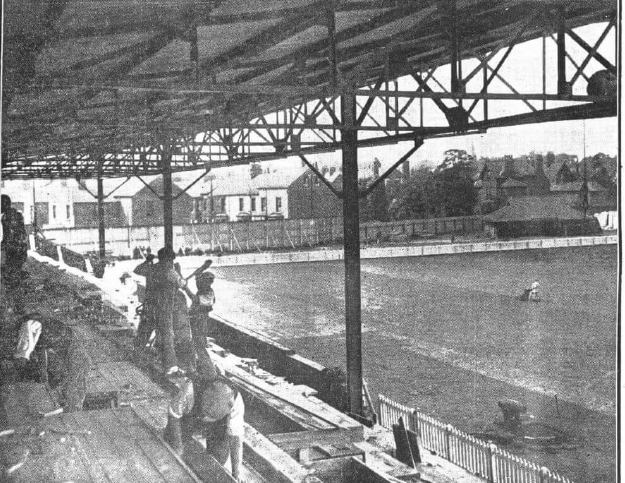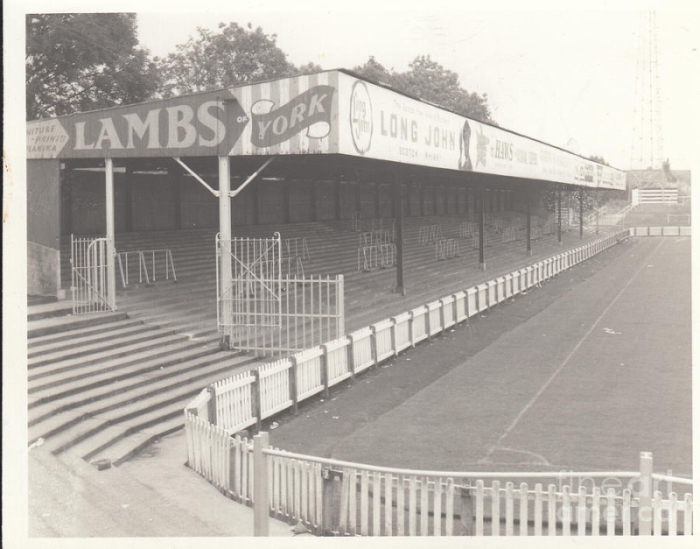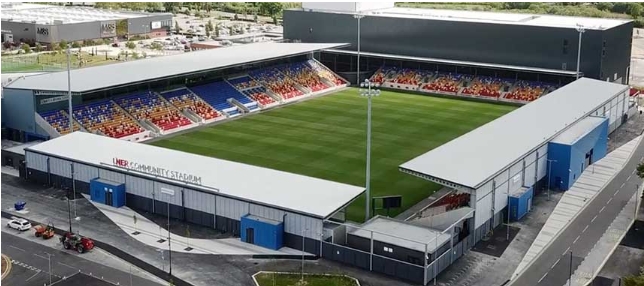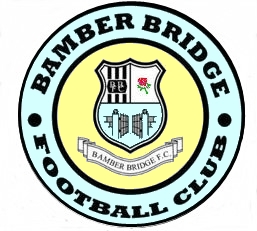|
 York City
York City 
In 2018, I travelled up to Workington with Bamber Bridge FC for a Northern Premier League Division 1 North match. On arrival at Borough Park I found I was enthralled with this ageing relic of a once substantial football stadium and found it to be a place oozing with character. That visit inspired me to write a few articles on some of the other old or lost grounds of Northern England. This time it’s the turn of The club that now play at the LNER Community Stadium!! Who plays there, I hear you ask? Well if I said they moved from Bootham Crescent, I dare say most people would instantly recognise that name as the Old home of York City FC. So here goes !! But first a bit of Pre – Bootham Crescent history.
York City FC were formed in 1922 and the club had purchased about 8 acres of Land for about £2,000 in Heslington Lane, in the Fulfordgate area of the City. This was Some distance away from the City Centre and eventually played a big part in their move to Bootham Crescent just 10 years later. The acquired land was actually known as Gate Fulford but became known as Fulfordgate. The ground initially had no stands until an uncovered stand was bought from York Racecourse. Over the next few years the ground improved with further covered terracing and stands. When York City applied to join the Football League in 1927, they over ambitiously announced that the ground would be expanded to hold 40,000 supporters They were elected to join The Football League in 1929! As it turned out, the largest gate at the ground was 12,721 for an FA Cup Tie against Sheffield Utd. With official Capacity being noted as 17,000

Main Stand at Fulfordgate
That was however a one off and
crowds were generally low, mainly due to the location of the stadium,
Quite remote and some distance from either the railway station or the
York tram service. Or indeed the main population of the City of York.
A York City Director by the
name of Mr GW Haliday realised by 1929 that if York City FC was to
have any future, they would have to move to a more readily accessible
Stadium, and in 1932, one such venue became available to lease. York
Cricket Club had decided to move out of their Bootham Crescent home,
close to the City Centre. Another deciding factor of the move was
that within 1 square mile of Bootham Crescent there was a local
population of 30,000. The population in the 1 square mile around
Fulfordgate was just 3,000.
Not all agreed, with some of
the original founders of the Club, particularly a Mr J Fisher arguing
that they had built a “playing History at Fulfordgate and had
massively improved that facilities at great expense. He also argued
that it was a bad policy moving from a ground they owned to one they
would only rent. However, the matter was put to a shareholders vote
and a majority of 3 to 1 voted for the move. Despite York City
challenging at the top of Division 3 North, gates at Fulfordgate were
averaging just over 4,000. It was felt this could be at least doubled
at Bootham Crescent.

Last match played at Fulforgate, April 1932 York City beat Halifax Town 7-2. Only 2,154 fans in attendance
York City FC took out a 14
year lease on Bootham Crescent in 1932 at an annual rent of £90.
Fulfordrgate was sold to finance development of their new home and is
now a housing estate with no trace at all of the old ground. It was expected
that City would play two more seasons at The old ground whilst their
new home was being developed. In the event they moved into Bootham
Crescent on August 31st
1932 when a match against Stockport County became the first League
match held at the new ground. The game ended 2-2 in front of 7,269
supporters. That season however was almost a disaster for York City,
the move coincided with poor performances on the pitch, the club only avoiding the need to
apply for re-election to the League with a win on the last day of the
season.
Fortunes improved during the
1930’s and in 1937/38, City reached the FA Cup Quarter Finals
breaking the Bootham Crescent highest attendance record in 4
consecutive rounds. 13,917 saw them beat Coventry City, 18,795 saw
them beat West Bromwich Albion, 23,860 were there for the tie against
Middleborough and the Grounds all time record attendance came when
28,123 watched the draw with Huddersfield Town in the Quarter Final,
Town won the replay and went on to the final losing 1-0 against
Preston North End.

Work in progress Summer 1932 at the new Bootham Crescent Ground
The Club had employed local
architects, Messers Ward and Leckenby to oversee the development of
the Stadium. The supporters Club of York City helped with the initial
upgrading of Bootham Crescent, by raising funds and each donating either a 1 penny coin or a threepenny coin (Threpenny bit) A not insignificant amount for working folk in the 1930’s. They raised approx £1,500 to pay for the new Popular Stand along one side of the pitch. Fund raising events were held and it is though that The Yorkshire Brewery provided the funds for a new social club on the opposite side next to the main stand. A plaque was erected on The Popular Stand noting the efforts of the supporters. It remained in place until the 1970’s.
upgrading of Bootham Crescent, by raising funds and each donating either a 1 penny coin or a threepenny coin (Threpenny bit) A not insignificant amount for working folk in the 1930’s. They raised approx £1,500 to pay for the new Popular Stand along one side of the pitch. Fund raising events were held and it is though that The Yorkshire Brewery provided the funds for a new social club on the opposite side next to the main stand. A plaque was erected on The Popular Stand noting the efforts of the supporters. It remained in place until the 1970’s.

Image of what may be to be a training session at Bootham Crescent in the 1930's
World War Two saw the Football
League suspended, however regional football was soon reinstated as a
means to boost morale. Clubs were able to call on Armed Forces
personnel based in the local area of the club, with York City City
drawing up on many Soldiers (many based at Strensall, Fulford and
Catterick) and Airmen stationed across Yorkshire and they played in
Semi Formal Leagues and cup competitions. In 1942/3, the Northern
Section consisted of 48 clubs, City finished 17th,
and in The North League War Cup, they reached the semi final before
losing to Sheffield Wednesday. Picture below.

1942 War Cup v Sheffield Wednesday, with fans on the roof of the stand
The ground also did it’s bit
for the war effort with areas within the Stadium used as air raid
shelters for a local school. A
Long tunnel the full
length of the Popular stand being the main area of protection. The
ground was damaged during an air raid on York in 1942. But less
fortunate where two rows of terraced houses, close by called
Pickering Terrace, which took a direct hit killing several residents.
For many years
the ground remained unchanged. In 1948 City purchased the ground, the
14 year lease having expired in 1946, City had taken out a new 21
year lease with annual rent increased to £125. A post War boom in
football attendances was occurring all across the Country and City
offered the Landowners £3,000 to buy the ground. This was rejected
but a further offer of £4,000 was accepted. Equivalent to about
£340,000 today. York City were now in a position to vastly improve
the Stadium
By the early 50’s the
Popular Stand and the Shipton Street end terraces were concreted
having previously been ash and cinders. The late 50’s saw the main
stand extended and Floodlights installed. The new floodlights also
brought an increase in attendances with fans noting an improved and
noisier atmosphere under the lights. The players were paid a bonus
when crowds topped 10,000.
In 1974, the Popular Stand
became seated with seats bought from Manchester City. Offices and new
dressing rooms were added. Hospitality boxes came in the 1980’s but
for some obscure
reason, they had no view of the pitch!! A family stand was created in
the Main stand and the standing enclosure in front of the seats was
fitted with seating all the way to pitch level. The Canopy of the
roof also extended to keep the supporters in the lower seats dry.

The Popular side at Bootham Crescent before seats were installed
In 1991 The new David
Longhurst stand was opened behind the goal at the Shipton Street end.
Named after the York City player who tragically died of a heart
attack on the pitch whilst playing for York City against Lincoln City
in 1990. The covered terrace had been in the pipeline for several
years and funds were raised to carry out the work. It was unanimously
decided to name the new stand
after David Longhurst.
The terrace could hold 4,000 fans and was opened for the first time
for a game against Gillingham in the 1991/92 Season. A new covered
stand was proposed for Grosvenor Road end but Grant aid was not
forthcoming and the stand was never built.

The David Longhurst Stand
In July 1999, York City’s
assets, including Bootham Crescent, were transferred to a holding
company called Bootham Crescent Holdings for £165,000. The Chairman
put the ground and the club up for sale for £4.5 million in December
2001 and It was announced that the ground would close by 30 June
2002. The ground was bought back in 2004 by The Supporters Trust. As
a consequence and to
raise funds The ground
was renamed The Kit Kat Stadium in
2005 when Chocolate
Makers ‘Nestle’ sponsored the stadium.
The Trust had secured a 2
million pound loan from the Football Stadia Improvement Fund to buy
back the ground. A major condition being that a new stadium would
eventually be built. York were relegated from the Football League in
2005, ending 72 years of League Football at Bootham Crescent.
Football continued at the
ground and City won
Promotion back to the Football League in 2012, but the stay lasted just 4
seasons before they were relegated once again. York City have
remained a non league club ever
since and suffered further relegation to The National League North.The club have now
returned to the National League with
realistic ambitions to regain their Football League status.

The main stand in the 1960’s
The condition of the loan to
buy back the stadium was that York City would have identified a new
site by 2007 and have detailed planning permission by 2009 once
achieved, the loan would become a grant. Persimmon Homes had a deal
in place to buy Bootham Crescent at 10% lower than market value. The
sale of the propsed 93 homes would go towards the cost of the new
stadium.
With annual maintenance costs
now running at £60,000 per year to keep the Old ground useable, it
was imperative for the future of York City Football Club that the new
stadium was built. The commitment to build a new stadium was
confirmed by York City Council in 2008, The new ground to be used
also by York City Knights Rugby League Club.
It wasn’t until 2017 that
work started at the new site in the Huntington area of the City.
After several more delays The new 8,500 Capacity Stadium, Leisure
Complex and Community Hub was eventually handed
over in 2020. The first match held at the new ground was York City v
AFC Fylde in February 2021. The visitors winning 3-1.

The LNER Stadium
http://www.yorkcitysouth.co.uk/default.htm

